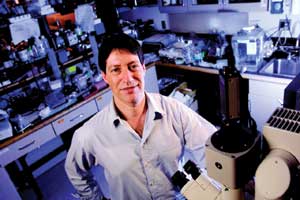From field to plastic to biodiesel

May 25, 2007
Scientists at the Polytechnic University in New York have been awarded $2.34 million over two years from the Defense Advanced Research Projects Agency (DARPA) to perfect a bioplastic made from vegetable oils that can be converted back to fatty acids for the production of biodiesel.
Richard Gross, director of the university's Center for Biocatalysis and Bioprocessing of Macromolecules, developed the new bioplastic. The process involves taking fatty acids-the same feedstock as biodiesel-and adding an alcohol (hydroxy) group to the final carbon in the chain to create an omega-hydroxy fatty acid. This synthesis is done with an engineered strain of the yeast Candida antarctica.
A commercially available enzyme made by Novozymes, called lipase, can then be used to create long-chain polyesters that have similar properties to polyethylene, according to Gross. By manipulating feedstocks and the conditions of the reaction, Gross has been able to create plastic films, thermoset plastics and structural plastics. "The kind of materials we are making fit perfectly in the world of polyethylene-based material," he said. "Plus, they have other properties that go above and beyond what a polyethylene can do. We have shown that material has really good properties."
The polyesters are biodegradable but break down much more slowly than other bioplastics, such as polylactic acid. However, an enzyme called cutinase will break apart the polyester bonds and turn the plastic back into fatty acids. The fatty acids can then go through transesterification with methanol to create biodiesel. "At the end of use, we can treat the plastic with an enzyme that breaks it back down into the monomer," Gross said. "We simply shred the polyester and treat it with the cutinase. It's really quite simple."
The DARPA grant will allow Gross to partner with biotech firm DNA 2.0 to improve the efficiency of each of the reactions. "The most critical step in this process is the monomer synthesis," Gross said. "We need a very efficient conversion of fatty acids to hydroxy-fatty acids. DNA 2.0 is doing the protein engineering part of the project, and we are then taking the variants and studying them in their selectivity and activity."
DARPA is funding the work on this bioplastic because military bases generate large quantities of packaging waste. If the waste can be converted to fuel, not only will it reduce the amount of waste that the military has to remove, but it will also reduce the amount of fuel that has to be delivered to military bases. This benefit is magnified for bases in combat zones, where supply lines can be long and dangerous to convoys.
By the conclusion of the grant, Gross hopes to have a cost-effective, efficient process. "That's where we want to get at the end of this two-year period," he said. "Then we can hand it off to an appropriate partner for commercialization."
Richard Gross, director of the university's Center for Biocatalysis and Bioprocessing of Macromolecules, developed the new bioplastic. The process involves taking fatty acids-the same feedstock as biodiesel-and adding an alcohol (hydroxy) group to the final carbon in the chain to create an omega-hydroxy fatty acid. This synthesis is done with an engineered strain of the yeast Candida antarctica.
A commercially available enzyme made by Novozymes, called lipase, can then be used to create long-chain polyesters that have similar properties to polyethylene, according to Gross. By manipulating feedstocks and the conditions of the reaction, Gross has been able to create plastic films, thermoset plastics and structural plastics. "The kind of materials we are making fit perfectly in the world of polyethylene-based material," he said. "Plus, they have other properties that go above and beyond what a polyethylene can do. We have shown that material has really good properties."
The polyesters are biodegradable but break down much more slowly than other bioplastics, such as polylactic acid. However, an enzyme called cutinase will break apart the polyester bonds and turn the plastic back into fatty acids. The fatty acids can then go through transesterification with methanol to create biodiesel. "At the end of use, we can treat the plastic with an enzyme that breaks it back down into the monomer," Gross said. "We simply shred the polyester and treat it with the cutinase. It's really quite simple."
The DARPA grant will allow Gross to partner with biotech firm DNA 2.0 to improve the efficiency of each of the reactions. "The most critical step in this process is the monomer synthesis," Gross said. "We need a very efficient conversion of fatty acids to hydroxy-fatty acids. DNA 2.0 is doing the protein engineering part of the project, and we are then taking the variants and studying them in their selectivity and activity."
DARPA is funding the work on this bioplastic because military bases generate large quantities of packaging waste. If the waste can be converted to fuel, not only will it reduce the amount of waste that the military has to remove, but it will also reduce the amount of fuel that has to be delivered to military bases. This benefit is magnified for bases in combat zones, where supply lines can be long and dangerous to convoys.
By the conclusion of the grant, Gross hopes to have a cost-effective, efficient process. "That's where we want to get at the end of this two-year period," he said. "Then we can hand it off to an appropriate partner for commercialization."
Advertisement
Advertisement
Advertisement
Advertisement
Upcoming Events





